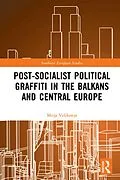This theoretically and empirically grounded book uses case studies of political graffiti in the post-socialist Balkans and Central Europe to explore the use of graffiti as a subversive political media.
Despite the increasing global digitisation, graffiti remains widespread and popular, providing with a few words or images a vivid visual indication of cultural conditions, social dynamics and power structures in a society, and provoking a variety of reactions. Using qualitative and quantitative methods, as well as detailed interdisciplinary analyses of "patriotic," extreme-right, soccer-fan, nostalgic, and chauvinist graffiti and street art, it looks at why and by whom graffiti is used as political media and to/against whom it is directed. The book theorises discussions of political graffiti and street art to show different methodological approaches from four perspectives: context, author, the work itself, and audience.
It will be of interest to the growing body of literature focussing on (sub)cultural studies in the contemporary Balkans, transitology, visual cultural studies, art theory, anthropology, sociology, and studies of radical politics.
Autorentext
Mitja Velikonja, PhD, is a Professor of Cultural Studies and Head of the Centre for Cultural and Religious Studies at the Faculty of Social Sciences, University of Ljubljana, Slovenia.
Inhalt
Preface: Toward a New Interdisciplinary Science - Graffitology
Part One: Introduction to Graffiti and Street Art Studies
- Mapping (Political) Graffiti and Street Art
- Dirty Words on Clean Walls - Dilemmas in Defining Graffiti and Street Art
- Poetics on the Wall: Characteristics of Aesthetic/Subcultural Graffiti and Street Art
- Politics on the Wall: Characteristics of Political Graffiti and Street Art
- Types, Styles and Techniques of Graffiti and Street Art
- Ways, Sites and Methods of Researching Political Graffiti and Street Art
- Graffitography - Photographing as a Way of Collecting Visual Data
- Multiangular Approach: Four Sites of Meaning of Graffiti
- Methods of Researching Political Graffiti and Street Art
- Yugoslavia after Yugoslavia: Graffiti and Street Art about Yugoslavia in the Post-Yugoslav Urbanscape
- Contested Heroes - Gavrilo Princip and Rudolf Maister as Subcultural Icons
- Nature as Politics - The Motif of Mt. Triglav in Graffiti and Street Art
- Shameful Compliance - Balkan Nationalist Graffiti and Street Art
- Spraying Hatred - Extreme-Right Graffiti and Street Art in Slovenia
- The New Others - Visual Ideology of Refugees in Contemporary Slovenia
- Chosen Few - Football Fan Graffiti and Street Art
- One Club, One Honor! - The Graffitiscape of Slovenian Football Fans
Part Two: Post-Socialist Graffiti-Scapes - Case Studies
Conclusion: Power of the Street (Art), Powerlessness of (Street) Art
